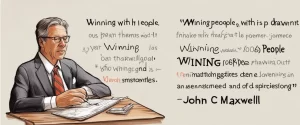——Speak to Win by Brian Tracy & Presenting to Win by Jerry Weissman
In today’s highly competitive professional world, effective communication skills play a pivotal role in determining an individual’s success and influence. Particularly in realms such as business, politics, or education, the ability to deliver impactful and persuasive presentations is key. To excel in this domain, one must not only master the art of public speaking but also understand the nuances of connecting with diverse audiences. In this comparative study, we will examine two highly acclaimed books on the subject: “Speak to Win” by Brian Tracy and “Presenting to Win” by Jerry Weissman. By exploring the unique perspectives and methodologies offered by these authors, we aim to gain insight into the most effective strategies for delivering compelling presentations that leave a lasting impact.
First, we will delve into “Speak to Win” by Brian Tracy, a renowned speaker and author who has trained individuals and organizations worldwide. In his book, Tracy posits that successful speaking is an essential skill for becoming a confident leader and influencer. Advocating for meticulous preparation, Tracy offers practical techniques for structuring presentations, capturing audience attention, and delivering powerful messages. He emphasizes the significance of honing one’s persuasive abilities, cultivating charisma, and aligning one’s words with their intentions. With a focus on maximizing impact, “Speak to Win” presents a comprehensive approach to public speaking that combines sound preparation, effective delivery, and resonating connection.
Secondly, we will explore “Presenting to Win” by Jerry Weissman, a seasoned communication coach who has advised top executives in companies such as Microsoft, Cisco, and IBM. Weissman’s book unveils a unique methodology rooted in storytelling, aiming to engage audiences on a deeper level. By analyzing the power of narratives, he suggests that presenters should craft compelling stories to convey their messages effectively. Weissman breaks down the presentation process into several key components, including clear structure, vivid visuals, and seamless delivery. Drawing from his extensive experience, Weissman highlights the importance of building rapport with listeners, adapting to different contexts, and addressing potential objections. By viewing presentations as persuasive stories, “Presenting to Win” provides a distinct perspective on how to captivate and resonate with diverse audiences.
In this comparative study, we will analyze and evaluate the strategies proposed by Brian Tracy in “Speak to Win” and Jerry Weissman in “Presenting to Win.” Through an examination of their distinct approaches, methodologies, and case studies, we seek to identify the underlying principles and techniques that contribute to successful presentations. By understanding the strengths and weaknesses of each author’s perspective, we can develop a more comprehensive understanding of the art of public speaking and leverage this knowledge to enhance our own communication skills.
This comparative study ultimately aspires to serve as a valuable resource for individuals aspiring to become proficient presenters and influential communicators. By drawing on the expertise and insights provided by Brian Tracy and Jerry Weissman, readers can gain fresh perspective, refine their presentation techniques, and elevate their ability to speak to win.
Brief Summary of Two Books
Speak to Win by Brian Tracy
“Speak to Win” by Brian Tracy is a comprehensive guide to becoming an effective public speaker. The book emphasizes the importance of mastering communication skills for success in various aspects of life, including business, career, and personal relationships. Tracy provides practical techniques and strategies to overcome fear and anxiety associated with public speaking, and offers guidance on building confidence, developing impactful presentations, and captivating audiences through powerful and persuasive language. The book also delves into the art of storytelling, persuasion, and effective body language, providing readers with a holistic understanding of the essentials needed to deliver compelling and influential speeches. Through numerous real-life examples and step-by-step instructions, Tracy encourages readers to embrace public speaking as a key tool for personal and professional growth, allowing them to communicate their ideas effectively and achieve their goals.
Presenting to Win by Jerry Weissman
Presenting to Win by Jerry Weissman is a comprehensive guide that helps individuals improve their presentation skills and become more effective communicators. The book emphasizes the importance of storytelling, structuring a presentation, and effectively engaging with the audience to leave a lasting impact.
Weissman provides numerous strategies and techniques to capture the audience’s attention from the beginning, using compelling visuals, and delivering a persuasive message. He emphasizes the art of crafting a clear and concise message, focusing on the audience’s needs and interests, and aligning the presentation with their goals.
The book also highlights the significance of practicing and rehearsing thoroughly to enhance confidence and delivery. It provides practical tips for overcoming nervousness, dealing with difficult questions, and handling technical glitches during presentations.
Moreover, Weissman delves into the different types of presentations, including sales pitches, investor presentations, and big-stage speeches. He guides readers on tailoring their messages to specific audiences and adapting their delivery techniques accordingly.
Throughout the book, Weissman reinforces his advice by sharing real-life examples from his extensive experience working with executives, entrepreneurs, and professionals from various industries. These stories illustrate how the techniques he suggests have helped individuals achieve successful outcomes in their presentations.
Overall, Presenting to Win presents a wealth of valuable insights, techniques, and practical advice that can significantly improve anyone’s presentation skills, making it a must-read for individuals seeking to make a lasting impact and achieve success in their professional and personal lives.
Comparison between Two Books

Similarities in Public Speaking
In both Speak to Win by Brian Tracy and Presenting to Win by Jerry Weissman, the authors provide valuable insights on public speaking and presentation techniques. These books share several similarities in terms of their approach and advice for effective public speaking. Here are some of the key similarities between the two books:
1. Importance of preparation: Both books emphasize the significance of thorough preparation before delivering a speech or presentation. Tracy and Weissman stress the need to research, organize thoughts, and rehearse extensively in order to come across as confident and well-prepared.
2. Clear and concise messaging: Both authors emphasize the importance of delivering a clear and concise message to the audience. They advocate for eliminating unnecessary jargon, using simple language, and conveying information in a manner that is easy to understand and remember.
3. Storytelling: Tracy and Weissman discuss the power of storytelling as a way to engage the audience. They highlight the effectiveness of including relevant anecdotes, personal experiences, and captivating stories to illustrate key points and make the presentation more memorable.
4. Visual aids: Both books touch upon the effective use of visual aids to enhance the presentation. Tracy and Weissman provide guidance on using PowerPoint slides or other visual aids sparingly, making sure that they support the speaker’s message without overpowering it.
5. Body language and confidence: The importance of confident body language is highlighted in both books. Tracy and Weissman stress the significance of maintaining eye contact, using appropriate gestures, and displaying confidence through posture and demeanor.
6. Audience analysis: Both authors emphasize the need to understand the audience and tailor the presentation accordingly. They discuss techniques for conducting audience analysis, identifying their needs, and adapting the speech or presentation to capture their attention and address their concerns.
7. Practice and feedback: Tracy and Weissman encourage continuous practice and seeking feedback to improve public speaking skills. They recommend videotaping practice sessions, seeking critique from trusted sources, and actively working on weaknesses to deliver more effective presentations.
While Speak to Win and Presenting to Win may have slight differences in their overall approach, both books offer valuable insights and practical techniques for mastering the art of public speaking. They provide readers with a comprehensive framework to enhance their abilities and effectively engage and persuade audiences.
Divergences in Public Speaking
Speak to Win by Brian Tracy and Presenting to Win by Jerry Weissman are both comprehensive books on public speaking that aim to help readers develop persuasive and engaging presentation skills. However, there are some key divergences between these two texts in terms of their approach and focus.
1. Structure and Delivery:
Speak to Win primarily focuses on the structure and delivery of a presentation. Tracy provides practical advice on creating well-organized speeches, developing powerful openings, using effective body language, and closing with impact. The book emphasizes the importance of carefully planning and rehearsing presentations to convey a strong message and captivate the audience.
Presenting to Win, on the other hand, places a stronger emphasis on storytelling and content development. Weissman illustrates the power of storytelling to convey ideas, connect with the audience, and make presentations more memorable. He provides techniques for crafting compelling narratives and using them effectively in presentations. Additionally, Weissman offers tips for creating convincing visuals to support the message and engage the audience visually.
2. Audience Engagement:
Tracy’s Speak to Win explores various techniques to engage the audience throughout the presentation. He offers strategies for grabbing and maintaining their attention, adapting to different personality types, and employing humor to create a positive and receptive atmosphere. Tracy emphasizes the importance of empathy and understanding the needs and expectations of the audience to deliver tailored messages.
In Presenting to Win, Weissman also addresses the importance of audience engagement; however, his approach focuses more on creating an emotional connection with the audience through storytelling and meaningful content. He encourages presenters to share personal experiences and anecdotes to resonate with the audience on a deeper level and establish credibility.
3. Overcoming Presentation Challenges:
Speak to Win dedicates a significant portion of the book to addressing common presentation challenges and providing solutions. Tracy provides advice on managing anxiety, overcoming fear, handling difficult questions, and dealing with distractions during presentations. He offers practical strategies to help presenters perform at their best in any situation.
Presenting to Win, on the other hand, tackles presentation challenges more broadly by focusing on overcoming resistance and objections. Weissman provides techniques for addressing objections proactively within the presentation itself, helping presenters boost credibility and effectively handle potential concerns or doubts raised by the audience.
In summary, Speak to Win by Brian Tracy and Presenting to Win by Jerry Weissman offer distinct approaches to public speaking. While Tracy’s book centers on the structure, delivery, and audience engagement, Weissman’s work emphasizes storytelling, emotional connection, and addressing objections. Both books provide valuable insights and strategies for becoming a confident and persuasive speaker, catering to different preferences and priorities of individuals seeking to enhance their public speaking skills.

Conclusion
Both “Speak to Win” by Brian Tracy and “Presenting to Win” by Jerry Weissman are highly regarded books on the topic of public speaking and presentations. However, the choice between the two depends on the specific needs and preferences of the reader.
If you are looking for a comprehensive guide on public speaking techniques, strategies, and overall communication skills, “Speak to Win” by Brian Tracy is a great option. Tracy is well-known for his expertise in personal development and success, and he provides valuable insights and practical tips to help readers become more effective and confident speakers.
On the other hand, if you are specifically interested in improving your presentation skills for business or professional settings, “Presenting to Win” by Jerry Weissman might be the better choice. Weissman is a well-respected presentation coach who has worked with top executives and leaders from various industries. His book focuses on crafting and delivering persuasive presentations that captivate audiences and achieve desired outcomes.
Ultimately, both books offer valuable knowledge and techniques, so it is recommended to consider your specific goals and interests when choosing between them. It may also be beneficial to read reviews and summaries of each book to determine which aligns better with your needs.



